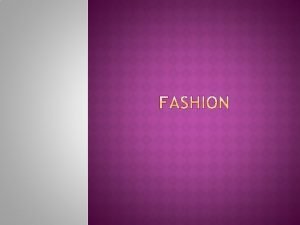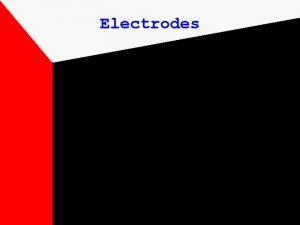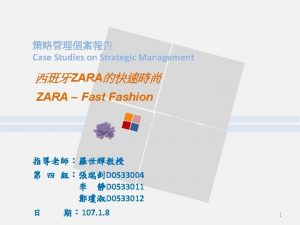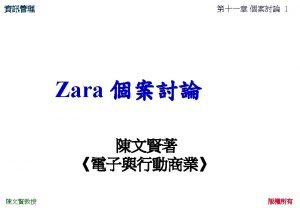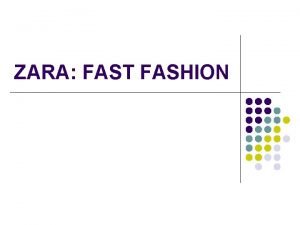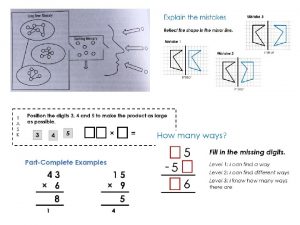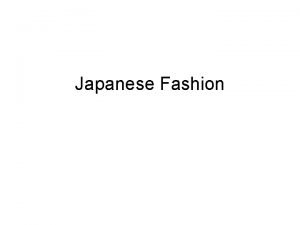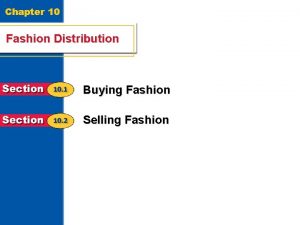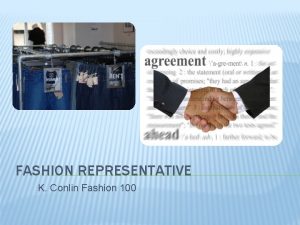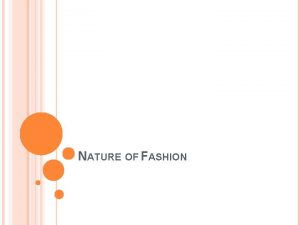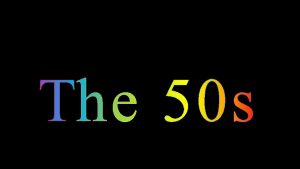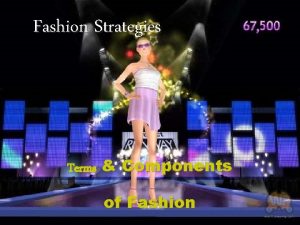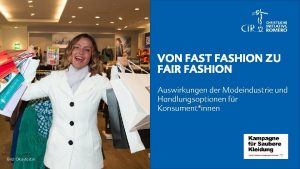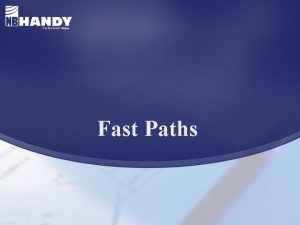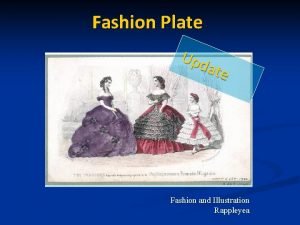Zara IT for Fast Fashion WE ARE GROUP




































- Slides: 36

Zara: IT for Fast Fashion

WE ARE GROUP A 1 ABHILASH KETHIPELLI 17 PGP 069 GUMMADI KRANTI KUMAR 17 PGP 056 DILEEP KARUMOJU 17 PGP 066 A KRANTHI KUMAR GOUD 17 PGP 002 KUNAL RAWAT 17 PGP 071 NANDINI BUSIREDDY 17 PGP 040 ABHINAV PODDAR 17 PGP 004 SAUMITH DAHAGAM 17 PGP 042 DIPALKUMAR PATEL 17 PGP 097 2

BRIEF OUTLINE OF PRESENTATION 1. 2. 3. 4. 5. 6. 7. 8. 9. 10. HISTORY OF ZARA ABOUT ZARA, THE FOUNDER : AMANICO ORTEGO THE KEY TO ZARA’S SUCCESS ZARA BUSINESS MODEL ZARA OPERATING MODEL COMPARISON OF BUSINESS MODELS INFORMATION NEEDED FOR OPERATION OF BUSINESS MODEL ZARA’S APPROACH TO INFORMATION TECHNOLOGY SWOT ANALYSIS SUMMARY 3

HISTORY OF ZARA 4

ABOUT ZARA, THE FOUNDER : AMANICO ORTEGO • Spanish clothing and accessories retailer • Founded in 1975 by Amanico Ortego and Rasalia Mera • A pioneer in fast fashion, he cofounded Zara parent Inditex • Ortega typically earns more than $400 million in dividends a year. • He has invested in an ever-expanding real estate portfolio, which includes buildings in Madrid, Barcelona, London, Chicago, Miami and New York. 5

“ The original business idea was very simple. Link customer demand to manufacturing, and link manufacturing to distribution. That is the idea we still live by. Jose Maria Castellano Rios, Inditex CEO 6

THE KEY TO ZARA’S SUCCESS Vertically Integrated supply chain where design, production, distribution and retailing were integrated “The vertical integration of our production system allows us to place a garment in any storearound the world in a period between two to three weeks” 7

ZARA BUSINESS MODEL What is Business Model ? Business model describes how a company produces, delivers and sells a product or service to create wealth 8

ZARA BUSINESS MODEL • Significant underserved segment • Delivering fast changing fashion style garments • Vertical integration • Fairly short life span, both within stores and in customers’ closets • No need of accurate long-range sales forecasts • Little inventory in Zara’s supply chain 9

ZARA BUSINESS MODEL Stores DCs Customers Design Manufac turing 10

ZARA BUSINESS MODEL SPEED & DECISION MAKING Decentralised decision -making Autonomy to store managers COMMERCIALS MARKETING Product development team to each section and specific collection 0. 3% of revenue spent on advertising Store product managers for market research More focus on location and look & feel of the stores Short life span fashionable clothing 11

ZARA BUSINESS MODEL ORDERING FULFILLMENT Physical count of existing stock App to manage supply and demand Application to serve different offers to each store Track of “theoretical inventory” of each SKU PDAs to view offer and order Highly automated and computerised DCs DESIGN & MANUFACTURING Introduction of new items throughout year Lead time of 3 weeks for new item Simple apps to plan production 12

ZARA OPERATING MODEL ▰ Processes are standardised in each store ▰ No interconnection between POS terminals and PDAs for information sharing 13

Competitors & 14

Comparison of Business Models Attribute H&M GAP ZARA Supply Chain Hybrid Traditional Fast Fashion Focus Commitment to longevity Focus cost minimization Focus on positioning Strategy Pull based Push based Pull based Suppliers Strategic partners Multiple partners Strategic partners Lead Time 1 week to 6 months 1 week – 2 months 2 weeks Inventory High holding stock Small frequent batches 15

Comparison of Business Models Attribute H&M GAP ZARA Warehouse Central Warehouse Multiple warehouse Single warehouse Distribution Centres In different Countries Few distribution centres Production Outsourced In house Marketing Expenses 3 -4% 0. 3% Mode of Selling Hybrid Multi Channel In store 16

IT Infrastructure H&M State of the Art IT Structure GAP ZARA Integrated IT and Transparency PDA POS 17

WEAKNESSES ▰ Nearly Zero Marketing Investment ▰ Youth’s affinity towards Online stores affects the Retail store sales ▰ Higher costs when expanding to farther locations due to the centralized distribution systems 18

SCALABILITY ▰Feasibility of Scalability is high ▰Due to strong supply-chain model in place, business processes are well defined ▰Strictly follows lean structure which means scaling up and scaling-down is flexible

Information Needed for Operation of Business Model ▰ Right information of the needs of the customer ▰ Able to accurately judge the taste of the people ▰ Awareness of the current requirements of the customers ▰ Able to ensure that the styles reach stores in time. 20

ZARA’s APPROACH TO INFORMATION TECHNOLOGY ▰ Preference for speed and Decentralized decision making ▰ No formal process or justifications for IT efforts ▰ Preference for making applications themselves rather than buying software commercially ▰ IT department had around 50 people recruited from local universities ▰ Almost all IT support of Inditex stores around the world was done from La Coruna 21

ZARA’s APPROACH TO INFORMATION TECHNOLOGY ▰ Internally developed applications prepared offers and distributed it to stores around the world and then received orders from them ▰ Another application compared the aggregated order to available inventory for each SKU ▰ Other application kept track of theoritical inventory of each SKU at each store ▰ Company was satisfied with manual checking of theortical inventory which gave 95% accuracy 22

How would you advise Salgado to proceed on the issue of upgrading Zara's POS systems? Should the company build in -store networks? Should the company upgrade the POS terminals to a modern operating system? • DOS is no more supported by Microsoft • Enables adding networking capability. • Zara is the only customer using the ancient operating system. • Employees had to carry the daily sales data in floppy disks and use in the other system. • Usage of PDAs which have small screen and hard to accomplish returns • For the benefits of employees and for the proper communication. 23

Should the company give employees the ability to look up inventory balances for items in their own stores and in other stores? • Every location would know the inventory level about the SKU’s in the other stores. • The store can ask for inventory transfer • These things are not possible with the existing POS terminal which runs on DOS system. • Customers or store need not rely on the fax machines, paper shortages etc. • Physical count of inventory takes more time than selling the goods • The automated counting system reduces the count error and miscommunications. 24

BIG DEAL? 25

POSITIVE SIDE OF THE COIN ▰ Current POS OS is stable ▰ No complaints from any store ▰ Adequate communication is possible ▰ Supplier has no plans to stop the selling ▰ Sufficient POS’s can be bought to avoid any failure 26

€ 2 million a year That’s a lot of money 80 new stores A lot of new stores per year € 160 million a year Too big compared to upgradation cost 27

NEGATIVE SIDE OF THE COIN ▰ Threat that supplier might not supply DOS-supported model ▰ Stock-checking is hard for the stores ▰ POS terminals are not linked with other stores ▰ Interface level is very fundamental ▰ Not flexible for emplyees 28

SWOT ANALYSIS Strength In-house production Very optimised supply chain Good brand equity Inventory turn around time is very less Technologically smart Weakness ZARA does not spend much money on advertisement Using DOS platform Stores could not see the inventory on its own and other stores Opportunity Online market Global market penetration Threat Global brands going online Local Competitors slices price of the products 29

Potential weakness of ZARA ▰ System used DOS OS which was not supported by Microsoft ▰ Stores cannot check the inventory balances in their stores and other stores ▰ POS was not networked, so every time the sales report had to be put on floppy and loaded to terminals. ▰ Using current system was time consuming as the screen size was small and it was difficult to input all information 30

What should ZARA do now? ▰ ZARA should check for the compatibility of new POS software with the system ▰ ZARA should check this on the pilot basis and decide what all benefits it can get after installing ▰ ZARA should also check that is it needed to give training for the new software to the store keepers ▰ ZARA have to check the compatibility of the two software so that data can be transferred successfully from one platform to another 31

32

Statistics Number of Stores Number of Countries 2003 2016 550 2213 45 93 Revenue 3. 1 bn $ 15. 9 bn $ Sales 4. 0 bn $ 17. 2 bn $ 33

34

Summary • Unique business model • Ability to understand their customers • Centralised inventory-faster store delivery • Diversification to Coordination 35

THANKS! 36
 Insidan region jh
Insidan region jh Yuppie meaning
Yuppie meaning Acid fast vs non acid fast
Acid fast vs non acid fast Example of acid-fast bacteria
Example of acid-fast bacteria Fast-fill electrode from the f1 group
Fast-fill electrode from the f1 group Fspos vägledning för kontinuitetshantering
Fspos vägledning för kontinuitetshantering Typiska drag för en novell
Typiska drag för en novell Nationell inriktning för artificiell intelligens
Nationell inriktning för artificiell intelligens Vad står k.r.å.k.a.n för
Vad står k.r.å.k.a.n för Shingelfrisyren
Shingelfrisyren En lathund för arbete med kontinuitetshantering
En lathund för arbete med kontinuitetshantering Särskild löneskatt för pensionskostnader
Särskild löneskatt för pensionskostnader Personlig tidbok fylla i
Personlig tidbok fylla i Sura för anatom
Sura för anatom Vad är densitet
Vad är densitet Datorkunskap för nybörjare
Datorkunskap för nybörjare Boverket ka
Boverket ka Debattartikel mall
Debattartikel mall Magnetsjukhus
Magnetsjukhus Nyckelkompetenser för livslångt lärande
Nyckelkompetenser för livslångt lärande Påbyggnader för flakfordon
Påbyggnader för flakfordon Kraft per area
Kraft per area Svenskt ramverk för digital samverkan
Svenskt ramverk för digital samverkan Jag har nigit för nymånens skära
Jag har nigit för nymånens skära Presentera för publik crossboss
Presentera för publik crossboss Teckenspråk minoritetsspråk argument
Teckenspråk minoritetsspråk argument Plats för toran ark
Plats för toran ark Treserva lathund
Treserva lathund Luftstrupen för medicinare
Luftstrupen för medicinare Claes martinsson
Claes martinsson Cks
Cks Verifikationsplan
Verifikationsplan Mat för unga idrottare
Mat för unga idrottare Verktyg för automatisering av utbetalningar
Verktyg för automatisering av utbetalningar Rutin för avvikelsehantering
Rutin för avvikelsehantering Smärtskolan kunskap för livet
Smärtskolan kunskap för livet Ministerstyre för och nackdelar
Ministerstyre för och nackdelar

